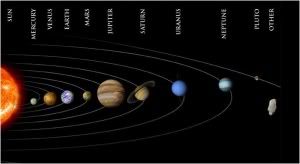8, 9, or 12? Let’s see how many people get the answer right? If I had not read the news yesterday, my answer would have been 9, or maybe 12 if I had tried to impress you that I was up to date on what Astronomers were thinking a few weeks ago. But now, both answers are considerd wrong. The correct answer is 8. Starting now, textbooks around the world that teach otherwise need to be revised and changed. And the same is true for Pakistan.

But how (and when) will Pakistan be able reflect these changes in its textbooks? What is the process for textbook revision in Pakistan? I also wonder how are we going to integrate new information, such as this, evolution theory and other issues including global climate change and advances in biomedical sciences, into our textbooks when we can’t even conclude our fights about the history of South Asian independence struggle and the idology behind the formation of Pakistan?
Here is how Pluto, the smallest (former) planet lost its status:
I assume most people reading this post also grew up learning in school textbooks that the solar system consisted of the Sun; nine planets, more than 130 satellites of the planets, a large number of small bodies (the comets and asteroids), and the interplanetary medium. The inner solar system constituted the Sun, Mercury, Venus, Earth and Mars, followed by the the main asteroid belt between the orbits of Mars and Jupiter, and the outer solar system was constituted by Jupiter, Saturn, Uranus, Neptune and Pluto.
All that information, that my primary school teachers used to all “general knowledge” has now been thrown up in the air by a changed definition of what constitutes a planet by the IAU (International Astronomical Union).
The IAU members gathered at the 2006 General Assembly agreed that a “planet” is defined as a celestial body that (a) is in orbit around the Sun, (b) has sufficient mass for its self-gravity to overcome rigid body forces so that it assumes a hydrostatic equilibrium (nearly round) shape, and (c) has cleared the neighbourhood around its orbit.
This means that the Solar System consists of eight “planets” Mercury, Venus, Earth, Mars, Jupiter, Saturn, Uranus and Neptune.
So what happened to Pluto? Well, Pluto has become a planet-emeritus. In IAU’s terms:
A new distinct class of objects called “dwarf planets” was also decided. It was agreed that “planets” and “dwarf planets” are two distinct classes of objects. The first members of the “dwarf planet” category are Ceres, Pluto and 2003 UB313 (temporary name). More “dwarf planets” are expected to be announced by the IAU in the coming months and years. Currently a dozen candidate “dwarf planets” are listed on IAU’s “dwarf planet” watchlist, which keeps changing as new objects are found and the physics of the existing candidates becomes better known.
The “dwarf planet” Pluto is recognised as an important proto-type of a new class of trans-Neptunian objects. The IAU will set up a process to name these objects.
And where did I get the idea that there may be 12 planets revolving around the Sun? From news, ofcourse. Before the IAU voted on the resolution to redefine what constituted a planet, there were rumors that the new definition would increase the number of planets from 9 to 12. On August 16, 2006, Boston Globe had reported that:
The solar system has 12 planets.
That is the conclusion, to be announced today, of an international panel formed to devise a scientific definition of a planet and settle an increasingly intense dispute over whether Pluto qualifies. The panel suggests retaining Pluto and immediately adding three new planets to the nine that are familiar to any schoolchild: Ceres, currently considered a large asteroid; Charon, now considered a moon of Pluto; and Xena, a recently discovered object that is larger than Pluto.
Anyways, there you have it. History has been changed, and it is now time to change the text books. The fact that the smallest guy got voted off the block in a democratic vote will be hard to explain to youngsters who are just now learning their planets in school classes. But I guess the line had to be drawn somewhere. Let’s wait and see how long before Pakistani textbooks are able to reflect the new information on the Nizam-e-Shamsi.


















































Text book especially of Pakistan’s are so old that their content really needs serious revision to increase educational level in Pakistani schools from federal to local or provincial governments.
please show me a big solar system
Some update: